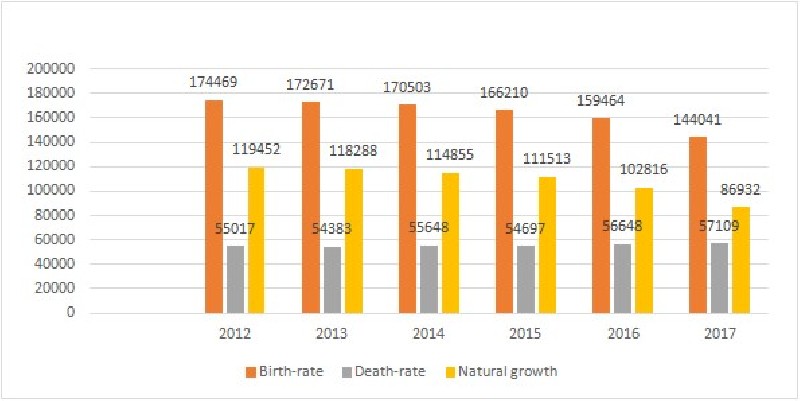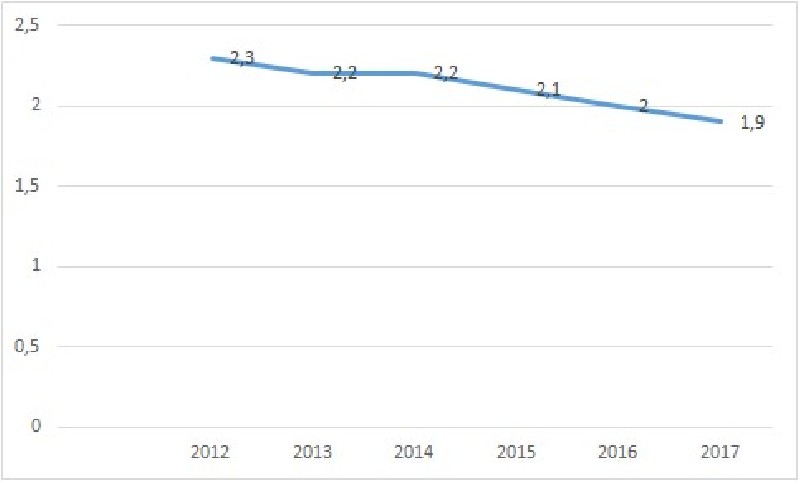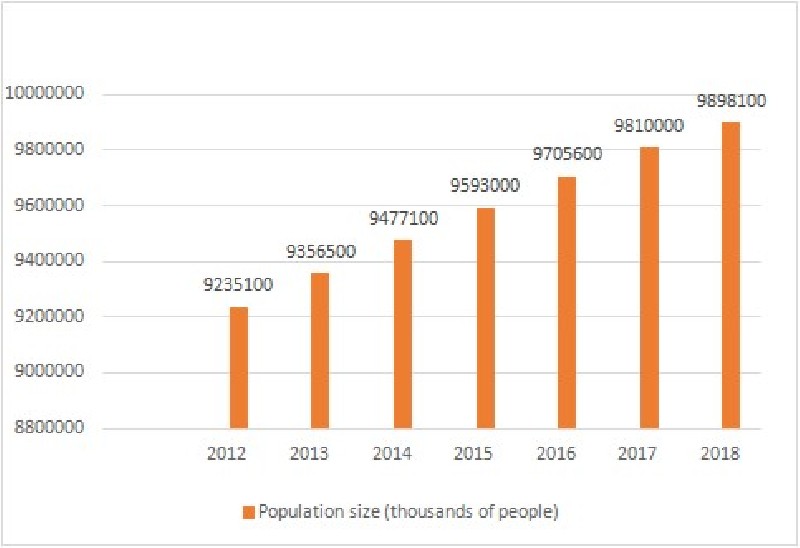
Фото из открытых источников
Worsening living conditions after 2015 negatively affected Azerbaijan"s demographic indices. The population"s natural growth rate has been declining since 2011 and the rate of decline has increased over the past three years.
According to the September 1, 2018 State Statistics Committee data, earlier this year the population increased by 52,427 persons or 0.5%, and reached 9,950,512. However, last year"s natural growth rate was 0.9%. The declining natural rate of growth reflects the worsening total birth- and death-rates in the country.
The low birth-rate coefficient is due to the declining total fertility coefficient, which specifies the average number of children one woman will bear during her reproductive period, from ages 15 through 49.
Of course, shortened lifespans result in reduced anticipated lifetimes at birth. For some time, women"s unwillingness to deliver girls have resulted in mass abortions, worsening the gross-coefficient of cohort reproduction. This coefficient matters most for demographic development; it indicates the average number of girls born during a woman"s reproductive period, and therefore the size of the potential cohort of a new generation of parents.
The population"s gross-coefficient of cohort reproduction is estimated as a cofficient of a generation"s fertility, but this estimation differs by taking only girls into account. This index fell from 1.1 in 2012 to 0.9 in 2017.
If the coefficient is equal to 1.0, then the correlation between the birth- and death-rates provide for the population"s reproduction. If the population"s net coefficient of reproduction is above or below 1.0, this means that the population is reproducing at a rate above or below its parents" generation. Today"s Azerbaijani parents are reproducing at a rate below their parents.
Although Azerbaijan"s population rose 40.7% since 1989, the number of Georgians dropped by 31.44% and Armenians by 9.12%. Further complicating the issue is that since 2011 our declining growth rate has become a real trend. To illustrate: in 2011 the natural growth in Azerbaijan was 122,310 persons; in 2012 the figure stood at 119,452; in 2013 at 118,288; in 2014 at 114,855; in 2015 at 111,513; in 2016 at 102,816 and in 2017 at 86,932.
From 2011 to 2018, annual natural population growth declined by 35,378 persons. The year of greatest decline was 2015 when the figure stood at 28,581.
During 2012-2017, the trends of natural growth, death- and birth-rates of the population were as follows:
Diagram 1. Number of natural growth, death and births in Azerbaijan

As is seen from Diagram 1, the death-rate trend is positive and the birth-rate trend is negative. Thus, the natural growth trend is declining, mainly due to the worsening general fertility coefficient in Azerbaijan. The coefficient dropped from 2.3 to 1.9 in the reviewed period. These changes are shown graphically in Diagram 2.
Diagram 2. Gross coefficient of fertility in Azerbaijan 2012-2017

As seen from Diagram 2, over the past 6 years a woman"s reproductive capacity fell from 2.3 to 1.9 children, on average. In other words, this coefficient is down by 2, leading eventually to a population decrease. Estimates show that if the population decrease continues at these rates, Azerbaijan"s population growth will end over the next decade and the natural growth rate will enter a phase of decline.
Azerbaijan"s present population is nearly 10 million. Estimates suggest that the 10 millionth child will be born in mid 2019.
Diagram 3 shows Azerbaijan"s population growth over the past 7 years. 2018"s index reflects the forecast.
Diagram 3. Population size of Azerbaijan 2012-2018.

Diagram 3 indicates that while the Republic"s population has risen, the rate of growth has fallen year by year when compared with the previous year"s level, as well as with 2012, designated the base year.
Experts suggest the main reasons for the decreasing natural growth rate include the rise in divorces and abortions because of unwillingness to have girls; the lack of positive changes in government"s care for children in light of worsening living conditions since 2015; the increasingly earlier death-rates, as well as the rise in migration abroad.
To my thinking, the government of Azerbaijan should immediately start awareness and regulatory campaigns to prevent abortions due to unwillingness to have girls, especially at the early stages of pregnancy.
Along with this, I suggest at least doubling the one-time maternity grants in Azerbaijan with due regard for current inflation and the minimum subsistence level for children.
By way of comparison, under presidential decree № 973 of August 29, 2013, effective September 1, 2013, the one-time benefit for a newborn was 90 manats. To compare: the lump-sum benefit for three children in Germany is Euro 3,588; in Denmark - $733.
Additionally, children up to eighteen years old should, in my view, receive a compulsory health package. It is essential to square income and family-paid taxes with the number of children in the family. It would be appropriate to grant special social packages to lower-income families and orphaned children, and, when assessing taxes for working parents, to provide benefits that consider the number of children in the family.
"Gross-coefficient of cohort reproduction rate for conventional generation is average number of girls that one woman can deliver provided she lives up to the end of reproduction period and preservation of today"s levels of birth-rate in each age". http://rybakovsky.ru/uchebnik2a32.html
"Gross-coefficient of cohort reproduction rate is calculated on the basis of the number of girls born by every woman on the average during her reproduction period and is equal to the aggregate birth-rate coefficient multiplied by the share of girls among the newborns: (see https://ru.wikipedia.org/wiki/population reproduction #Gross-coefficient of cohort reproduction) -Ed.
"Net-coefficient of cohort reproduction is an average number of girls born by one woman provided she lives up to the end of reproduction period under given levels of birth- and death-rates of the population". http://rybakovsky.ru/uchebnik2a32.html - Ed.
Under a presidential decree № 747 dated January 19, 2016, the benefit rose 10% on the average since February 1, 2016 - Ed.












Leave a review